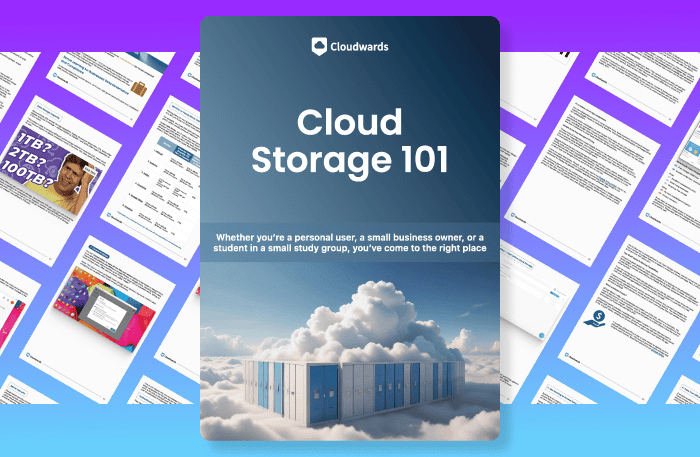Cloud Storage vs External Hard Drive: Advantages & Disadvantages in 2025
When your device is short on storage, you need somewhere else to save your data. In this comparison, we look at cloud storage vs external hard drives to see which is the better option.
While both options offer more storage space, there are several factors to consider in the cloud storage vs external hard drive debate. An external hard drive will give you more control over your data. However, cloud storage providers automatically back up your data and allow for easier file sharing.
You can’t go wrong with cloud storage, as it offers more flexibility and data-saving capabilities than external drives. Read on to find out how these options stack up against each other. Spoiler: Our favorite cloud service is Sync.com for its ease of use, excellent security and privacy and great value for money.
-
03/04/2024 Facts checked
We rewrote this guide to provide a better comparison between using cloud storage and an external hard drive. We also included a top cloud storage recommendation.
-
06/11/2025 Facts checked
We’ve added more details on the pros and cons of both cloud storage and external hard drives, suggested more cloud storage options and expanded the FAQs.
What Is Cloud Storage?
Cloud storage lets you store files on an online server instead of on your local device. Third-party providers such as Sync.com or pCloud manage these servers. You can adjust the amount of cloud storage you need, create automatic backups and sync your files across multiple devices.
The online functionality of cloud storage and its file-sharing capabilities make it a viable option for remote working. Some cloud storage providers also come with extra collaboration tools, such as a comment function and customizable sharing permissions.
10,000+ Trust Our Free Cloud Storage Tips. Join Today!

- Demystify cloud storage terminology and key concepts in plain language
- Discover easy-to-implement techniques to securely backup and sync your data across devices
- Learn money-saving strategies to optimize your cloud storage costs and usage
Advantages of Cloud Storage
There are multiple benefits to storing your data on the cloud. We explain a few of them below:
- Access your files anywhere: If you have internet access, you can sign in to your cloud storage account wherever you are. Most providers allow you to access your account from your browser, desktop or mobile device.
- Sync your files: Uploading your files to the cloud means you can keep up-to-date copies in an easily accessible location. You can also share uploaded files with others and ensure everyone has the most recent version.
- Low maintenance: The cloud provider takes care of all the physical maintenance of cloud storage servers. Most providers also allow you to automatically back up files. The only responsibility you have is to pay your bill on time.
Disadvantages of Cloud Storage
Though convenient, there are some downsides to storing your files online. The disadvantages of cloud providers include the following:
- Data insecurity: Uploading any file to cloud servers means it’s in the hands of a third-party provider. Though most services have security-focused data policies, be careful about what you’re saving to the cloud.
- Higher costs over time: Choosing cloud storage means signing up for a recurring monthly or annual fee. Free services don’t offer a lot of space or have poor privacy. Lifetime plans are also an option, but they can be prohibitively expensive if you need more storage for only a short amount of time.
- Online only: Access to the cloud is entirely dependent on whether you have an internet connection. While some providers offer a form of offline access, you’ll have to connect to WiFi at some point to sync files or upload changes. You may also have issues if you have very slow upload speeds.
What Is an External Hard Drive?
An external hard drive is a local storage solution that doesn’t require an internet connection. It’s a physical disk drive accessed via a USB port. They vary in digital size, though the most common options range between 1TB and 5TB. Transfer speeds between your device and the drive depend on whether you use USB 2.0, 3.0 or 4.0 ports.
Advantages of External Hard Drives
Having a local drive to store your files on can offer several advantages, including the following:
- Secure and private: Only the person with the external drive can access the data saved to it. If you don’t give the drive to anyone, your files are always in your control.
- Easy to use: You don’t need to remember passwords or learn a new interface when you use an external drive. The storage integrates seamlessly with your operating system’s file browser.
- Offline sync: External drives are a great portable option if you’re traveling in places without an internet connection.
Disadvantages of External Hard Drives
Investing in local storage can come with some challenges. We explain some of the downsides of getting an external hard disk below:
- High maintenance: External hard drives don’t last forever, and they can get lost or damaged. If this happens, your data could be permanently lost. You’re responsible for backing up your files and replacing your drives before they corrupt your data.
- Lack of sharing capabilities: Besides handing over your drive to someone else, there’s no way of sharing files with other people. Syncing files between devices is also much more tedious.
- Can be pricey: The more space you need, the more expensive storage solutions become. With external drives, you have to pay the entire cost up front.
Cloud Storage vs External Hard Drive: Pros & Cons Compared
Now that you know the advantages and disadvantages of cloud storage services and external hard drives, it’s time to compare their features directly side by side.
The Best Cloud Storage Alternatives to an External Hard Drive
1. Sync.com
Sync.com has one of the best data backup systems. We like that you can view and restore previous file versions or even deleted files, with version history of up to a year. If you need a lot of storage space or have a team of people, Sync.com has an unlimited plan that supports up to three users.
One downside of the service is that you can’t pay for the smaller storage capacity option in monthly installments — these are available only as annual subscriptions. See our full Sync.com review for more details on pricing.
- 5GB
- 2TB
More plans
- 6TB
- per user, per month, billed annually
- 1TB
- Priced per user (3 users minimum)
- Unlimited GB
- Minimum 100 users, custom requirements, account manager, training options
2. pCloud
pCloud stands out for its included media player that lets you view photos, audio files and videos within the app. You can create, save and load custom playlists and set a sleep timer. With a 10TB storage plan, pCloud is ideal if you have many large media files to store.
Unfortunately, pCloud doesn’t include its client-side file encryption in premium plans by default — instead, it’s a paid add-on. We found this disappointing, as client-side encryption prevents the cloud provider from accessing your data. Check out our pCloud review to learn about its other features.
- 10GB
- 500GB
- 2TB
More plans
- 10TB
- + FREE Encryption
- 2TB
- + FREE Encryption
- 10TB
- Price per user (minimum 3)
- 1TB
- Price per user (minimum 3)
- 2TB
- Encryption for pCloud Drive
3. Icedrive
Icedrive’s biggest plus is its virtual drive, which mounts directly to your operating system. This offers an intuitive and easy-to-use interface, especially if you’re transitioning from an external hard drive. With a lifetime plan, you can add bite-sized chunks of storage space if you run out of room.
Unfortunately, Icedrive provides client-side encryption for one folder only. This means you need to manually organize sensitive files there, which is a drawback if you’re looking for full-environment encryption. Take a look at our Icedrive review for more details on its security.
- 10GB
- 1TB
- 3TB
More plans
- 5TB
- 2TB
- Additional 1TB storage for users who purchased the Lifetime Plan
- 1TB
- Additional 5TB storage for users who purchased the Lifetime Plan
- 5TB
Final Thoughts
Whether you choose a hard drive or cloud storage depends on your specific needs. An external hard disk drive is an attractive option for greater privacy. However, we recommend using the cloud if you move files around often and need more organization. Sync.com is our top choice for this.
What’s your go-to option when you need more data storage? Do you think cloud storage is secure enough, or do you prefer local drives? Are there any cloud storage features you couldn’t live without? Let us know in the comments, and thank you for reading.
FAQ: External Hard Drive vs Cloud Storage
If you want a more convenient user experience, frequent and automatic data backups or just don’t want to maintain a physical drive, we recommend cloud storage. However, external hard drives are great if you need offline storage and prioritize full control over your data.
Cloud storage comes with features like file sharing, multiple backups and data loss protection — perks that local storage doesn’t provide. Most cloud providers commit to keeping your data private and also offer two-factor authentication and client-side encryption.
An external drive offers better security than iCloud, which we don’t recommend as a backup option. However, a dedicated cloud service provider such as Sync.com is a more secure and versatile alternative to an external drive. It has apps for iOS, Android and desktop devices.
Yes — using an online backup service, you can back up your entire system, including all files and system states. You can also schedule frequent backups and restore previous files. However, unlike a cloud storage service, you won’t be able to view your files until you need to restore them.





![Video thumbnail for the video: Ultimate Icedrive Review [2024 Pros and Cons Revealed]](https://img.youtube.com/vi/iVGsDxYVV-Y/maxresdefault.jpg)
